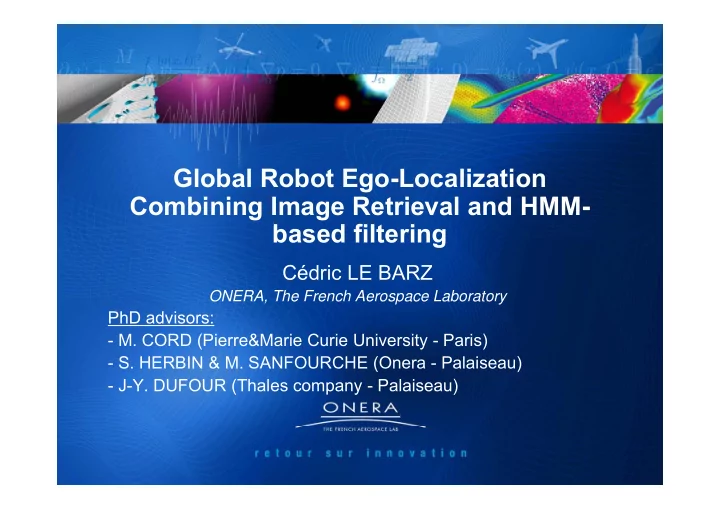

Global Robot Ego-Localization C Combining Image Retrieval and HMM- bi i I R i l d HMM based filtering Cédric LE BARZ ONERA, The French Aerospace Laboratory PhD PhD advisors: d i - M. CORD (Pierre&Marie Curie University - Paris) - S. HERBIN & M. SANFOURCHE (Onera - Palaiseau) ( ) - J-Y. DUFOUR (Thales company - Palaiseau) 1
Context illustration A Amazon Prime Air P i Ai 2
Autonomous navigation Needs accurate & absolute localization Accuracy required to follow trajectory and compute Accuracy required to follow trajectory and compute appropriate commands Absolute localization required because mission is specified q p with absolute coordinates GPS ? May be absent (shadowing effect) May be jammed (military missions) Precision about 10m An other information source is needed to deal with GPS drawbacks. Our proposal: use visual information…like humans Our proposal: use visual information…like humans 3
Our objective: visual absolute localization How to find, in a geo-referenced image database, the image depicting the same scene as the last th i d i ti th th l t image acquired by the robot (request image) ? Image retrieval problematic Nice feature would be: Use a freely available and wide coverage geo-referenced image database … like Google Streetview 4
Image retrieval: State of the arts Image Retrieval (IR) algorithms Vote based methods (kNN) Vote based methods (kNN) Dictionary based methods (BOVW) Descriptor modelization based methods (VLAD) Descriptor modelization based methods (VLAD) Kernel based methods Based on local descriptors. Construction of a compact signature, which is then used for IR task. p g , 5
Image retrieval Sometimes it works well ….. 6
Image retrieval 7
Image retrieval 8
Image retrieval Sometimes it does not … 9
Image retrieval 10
Image retrieval Many disparities may occur: points of view, illumination conditions, focal length, scene objects (car, people, vegetation…) Visual matching methods are sensitive to these disparities How can we make visual localization more robust ? 11
Our approach (1/2) Combine visual information with odometric measurements (hybrid system) measurements (hybrid system) 12
Our approach (2/2) Goal: find the trajectory that best explain observations T Trajectory can be seen as a j t b sequence of states Where each state is associated with a geo-referenced image ith f d i Means: HMM Hidden states are places p 13
HMM: ‘ Π ’ vector Π is the initial state distribution vector: the probability that the first state/position is a particular state/positio Example: If we are in state S3 with the uniform uncertainty hypothesis, then Π =[0;1/3;1/3;1/3;0;0] ‘ Π ’ enables to take into account initial estimated position and initial Π enables to take into account initial estimated position and initial localization uncertainty 14
HMM: ‘A’ matrix A={a ij } is the transition probability matrix between each state a ij =P(q t+1 =S j | q t =S i ) Example: From state S2, odometric measurements enables to estimate state S4. If we consider uniform uncertainty about odometric measurements, then a 2,j = [0;0;1/3;1/3;1/3;0] [ ] 2,j ‘A’ enables to take into account odometric measurements and odometric uncertainty ( a priori information) 15
HMM: ‘B’ matrix B is the likelihood to get a specific observation given the state P(O|S) the state P(O|S) Enable to take into account visual similarity between observations and geo-referenced database geo referenced database images Visual similarity is computed from the number of matching descriptors of matching descriptors between each request image and database images images 16
Qualitative results: Example 17
Qualitative results : Example 18
Experiments / Evaluation Image Image database number Request Google street view 1105 1 image images every ~10m Geo-referenced ‘Pittsburgh’ 2215 1 image database database (provided (p every ~5m y Images by Google company) 11 km trajectory 640x480 images 19
Results: Mean error localization vs. initial localization uncertainty Odometric uncertainty 10m Odometric uncertainty 10m 5 observations (*) A Zamir and M Shah “Accurate image localization based on google maps street view ” in ( ) A. Zamir and M. Shah, Accurate image localization based on google maps street view, in Proceedings of the European Conference on Computer Vision. IEEE, 2010, pp. 255–268. 20
Result : Mean error localization vs. number of observations Sensitivity of our solution to the number of past observations used, according the initial localization uncertainty U • Odometric uncertainty: 10m = > The higher U, the more observations number have to be considered to keep the mean error localization under a threshold. 21
Conclusions & Perspectives Conclusion We proposed a hybrid method that combines odometric measurements with visual similarity measurements. Advantages Improve image retrieval / Reduce error localization Complete re-estimation of the last part of the trajectory when required (long-term navigation) i d (l t i ti ) Developed framework can easily integrate new IR solutions Can be used for the kidnapped robot problem Can be used for the kidnapped robot problem Improvements Learn HMM parameters (‘A’ matrix) Learn HMM parameters ( A matrix) Improve visual similarity measurements (‘B’ matrix) Find discriminative and representative elements thanks to learning Find discriminative and representative elements thanks to learning Improve localization accuracy thanks to pose estimation ( 22
Thank you for your attention Questions ? 23
Recommend
More recommend